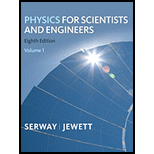
(a)
The expression for the two forces in unit vector notation.
(a)
Answer to Problem 7.61AP
The expression for the first force in unit vector notation is
Explanation of Solution
The mass of an object is
Write the formula to calculate the expression for the first force in unit vector notation is
Here,
Write the formula to calculate the expression for the second force in unit vector notation
Here,
Conclusion:
Substitute
Substitute
Therefore, the expression for the first force in unit vector notation is
(b)
The total force exerted on the object.
(b)
Answer to Problem 7.61AP
The total force exerted on the object is
Explanation of Solution
Write the formula to calculate the total force exerted on the object
Here,
Conclusion:
Substitute
Therefore, the total force exerted on the object is
(c)
The acceleration on the object.
(c)
Answer to Problem 7.61AP
The acceleration on the object is
Explanation of Solution
Write the formula to calculate the acceleration of the object
Here,
Conclusion:
Substitute
Therefore, the acceleration on the object is
(d)
The velocity on the object.
(d)
Answer to Problem 7.61AP
The velocity on the object is
Explanation of Solution
Write the formula to calculate the velocity of the object at
Here,
Conclusion:
Substitute
Therefore, the velocity on the object is
(e)
The position on the object.
(e)
Answer to Problem 7.61AP
The position on the object is
Explanation of Solution
Write the formula to calculate the position of the object
Here,
Substitute
Conclusion:
Therefore, the position on the object is
(f)
The kinetic energy of the object from the formula
(f)
Answer to Problem 7.61AP
The kinetic energy of the object from the formula
Explanation of Solution
Write the formula to calculate the magnitude of the final velocity of the object
Here,
Substitute
Write the formula to calculate the kinetic energy of the object
Conclusion:
Substitute
Therefore, the kinetic energy of the object from the formula
(g)
The kinetic energy of the object from the formula
(g)
Answer to Problem 7.61AP
The kinetic energy of the object from the formula
Explanation of Solution
Write the formula to calculate the magnitude of the initial velocity of the object
Here,
Substitute
Write the formula to calculate the final kinetic energy of the object
Conclusion:
Substitute
Therefore, the kinetic energy of the object from the formula
(h)
The conclusion by comparing the answer of part (f) and (g).
(h)
Explanation of Solution
Newton gave the law for the constant acceleration motion while the work energy theorem relates the work done by the object to its energy.
In part (f) the kinetic energy of the object is calculated with the help of Newton’s law while the kinetic energy in part (g) is calculated by the work energy theorem. Since in both the parts the kinetic energy of the object comes out to be same that conclude both the law and theorem are relevant to each other. The work energy theorem is consistent with the Newton’s law.
Conclusion:
Therefore, the work energy theorem is consistent with the Newton’s law of equation.
Want to see more full solutions like this?
Chapter 7 Solutions
Physics for Scientists and Engineers, Volume 1, Chapters 1-22
- Identical rays of light enter three transparent blocks composed of different materials. Light slows down upon entering the blocks.arrow_forwardFor single-slit diffraction, calculate the first three values of (the total phase difference between rays from each edge of the slit) that produce subsidiary maxima by a) using the phasor model, b) setting dr = 0, where I is given by, I = Io (sin (10) ². 2arrow_forwardA capacitor with a capacitance of C = 5.95×10−5 F is charged by connecting it to a 12.5 −V battery. The capacitor is then disconnected from the battery and connected across an inductor with an inductance of L = 1.55 H . (D)What is the charge on the capacitor 0.0235 s after the connection to the inductor is made? Interpret the sign of your answer. (e) At the time given in part (d), what is the current in the inductor? Interpret the sign of your answer. (f) Atthe time given in part (d), how much electrical energy is stored in the capacitor and how much is stored in the inductor?arrow_forward
 Physics for Scientists and Engineers with Modern ...PhysicsISBN:9781337553292Author:Raymond A. Serway, John W. JewettPublisher:Cengage Learning
Physics for Scientists and Engineers with Modern ...PhysicsISBN:9781337553292Author:Raymond A. Serway, John W. JewettPublisher:Cengage Learning Physics for Scientists and EngineersPhysicsISBN:9781337553278Author:Raymond A. Serway, John W. JewettPublisher:Cengage Learning
Physics for Scientists and EngineersPhysicsISBN:9781337553278Author:Raymond A. Serway, John W. JewettPublisher:Cengage Learning Physics for Scientists and Engineers: Foundations...PhysicsISBN:9781133939146Author:Katz, Debora M.Publisher:Cengage Learning
Physics for Scientists and Engineers: Foundations...PhysicsISBN:9781133939146Author:Katz, Debora M.Publisher:Cengage Learning Glencoe Physics: Principles and Problems, Student...PhysicsISBN:9780078807213Author:Paul W. ZitzewitzPublisher:Glencoe/McGraw-Hill
Glencoe Physics: Principles and Problems, Student...PhysicsISBN:9780078807213Author:Paul W. ZitzewitzPublisher:Glencoe/McGraw-Hill Physics for Scientists and Engineers, Technology ...PhysicsISBN:9781305116399Author:Raymond A. Serway, John W. JewettPublisher:Cengage Learning
Physics for Scientists and Engineers, Technology ...PhysicsISBN:9781305116399Author:Raymond A. Serway, John W. JewettPublisher:Cengage Learning Principles of Physics: A Calculus-Based TextPhysicsISBN:9781133104261Author:Raymond A. Serway, John W. JewettPublisher:Cengage Learning
Principles of Physics: A Calculus-Based TextPhysicsISBN:9781133104261Author:Raymond A. Serway, John W. JewettPublisher:Cengage Learning





